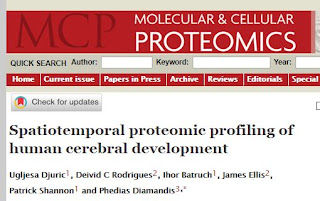Thursday, July 13, 2017
Spatiotemporal proteomic profiling of human cerebral development!
This study is incredible! I passed over it once because I was sure that this was another bait-and-switch paper. The title says human, but I figured the work was probably done on mouse or drosophila brains. Nope. This is perfectly performed single shot LFQ proteomics on human post-mortem FFPE brain tissue! (Nothing wrong with model organisms, no criticism intended, we can learn a lot from those too! But...human brains in early development?!?! Wow! Have you seen this before? I haven't!) You can check it out in press at MCP here.
They also did a lot with in vitro cells forced into differentiation, which I guarantee is interesting to people out there as well.
Check out those Venn diagrams! They get reproducible quan without missing values on an impressive number of proteins from the formalin fixed tissues. We've seen higher numbers in some other studies, but these are specifically taken from one area of the brain and robustness of quantification is the focus here. Honestly -- if they mentioned this in the paper I didn't see it -- but I wouldn't be surprised from the way this is done that we aren't looking at a group directly considering clinical applications for this beautiful study design,
A remarkably low amount of peptides were used on column (I'm too late this morning to do the math) and the nLC separation was only 60 minutes on a 15 cm column -- and they quantified >3,000 proteins! Not to get too excessively excited, but I love this trend of shorter nLC columns and gradients for today's faster instruments. A quadrupole Orbitrap (plus) type system was used.
The data hasn't been triggered for release on ProteomeXchange, but it will be available here when it does (PXD004076 for the FFPE tissue). Actually, the authors put in the reviewer login information so it can be accessed prior to release trigger, but I shouldn't be looking at beautiful RAW files. I should be getting ready for some meetings.
Subscribe to:
Post Comments (Atom)


No comments:
Post a Comment